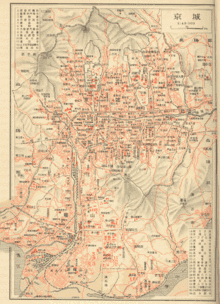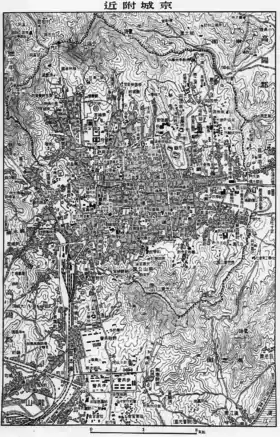| Keijō-fu 京城府 | |
|---|---|
| Former administrative district of Korea | |
 Emblem of Keijo
| |
 Map of Keijo in 1937 | |
| Population | |
• 1940 | 1,142,000 |
| Today part of | South Korea |
| Keijō | |
|---|---|
| Japanese name | |
| Kanji | 京城府 |
| Hiragana | けいじょうふ |
| Romanization | Keijō-fu |
| Korean name | |
| Hangul | 경성부, 게이조부 |
| Hanja | 京城府 |
| Revised Romanization | Gyeongseong-bu, Geijo-bu |
| McCune–Reischauer | Kyŏngsŏng-bu, Keijo-pu |


Keijō (京城), or Gyeongseong (Korean: 경성), was an administrative district of Korea under Japanese rule that corresponds to the present Seoul, the capital of South Korea.[1]
History
When the Empire of Japan annexed the Korean Empire, it made Seoul the colonial capital. While under colonial rule (1910–1945), the city was called Keijō (京城); (경성; Gyeongseong; Kyŏngsŏng, literally meaning "capital city" in Hanja.).[2] Keijō was an urban city (부/府) that had 2 wards: Keijō itself and Ryusan-ku (龍山區, 용산구, りゅうさんく). Gyeongseong was part of Gyeonggi Province, instead of being an independent city or prefecture as in Joseon and present days. In 1914, several outer districts of the prefecture were annexed to neighboring Goyang County (now Goyang City, reducing the administrative size of the prefecture. In 1936, Gyeongseong expanded itself as it annexed Yeongdeungpo from Siehung County (Now Siehung City) and recombined some parts of former Gyeongseong districts (Sungin, Yeonghee, etc.) from Goyang County. The Government-General Building served as the seat of the colonial government of Colonial Korea but was torn down in 1995.
Honmachi
| Honmachi | |
|---|---|
 | |
| Japanese name | |
| Kanji | 本町 |
| Hiragana | ほんまち |
| Romanization | Hommachi |
| Korean name | |
| Hangul | 혼마치 |
| Hanja | 本町 |
| Revised Romanization | Honmachi |
| McCune–Reischauer | Honmach'i |
The central district of Gyeongseong was Honmachi, present-day Chungmu-ro.
Demographics
| Year | Population |
|---|---|
| 1910 | 197,000[3] |
| 1920 | 251,000[3] |
| 1930 | 677,000[3] |
| 1940 | 1,142,000[3] |
See also
References
- ↑ ko:경성부, <Global World Encyclopedia>-(Seoul of Korea under Japanese rule)
- ↑ Yu, Woo-Ik; Lee, Chan (4 November 2019). "Seoul". Encyclopedia Britannica. Retrieved 4 July 2020.
- 1 2 3 4 "Seoul Statistical Yearbook". Statesman's Yearbook and World Atlases. 2000. Archived from the original on October 26, 2000.
